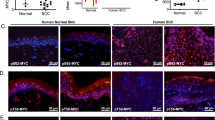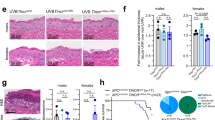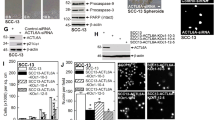Abstract
Protein kinase C (PKC)-δ is proapoptotic in human keratinocytes, and is downregulated or inactivated in keratinocytes expressing the activated Ha-ras oncogene, making it a candidate tumor suppressor gene for squamous cell carcinoma (SCC). We evaluated the significance of PKC-δ loss in transformed human keratinocytes using tumorigenic HaCaT Ras II-4 cells that have significantly reduced PKC-δ levels. Re-expression of PKC-δ by retrovirus transduction caused an increase in apoptosis and growth inhibition in culture. The growth inhibition induced by PKC-δ could be partially reversed by Bcl-xL expression, indicating that apoptosis was in part responsible for PKC-δ-induced growth inhibition. PKC-δ re-expression suppressed the tumorigenicity of HaCaT Ras II-4 cells in nude mice (P<0.05), and the small tumors that did form contained elevated levels of activated caspase-3, indicating increased apoptosis. In addition, we found that 29% (12/42) of human Bowen's disease (squamous carcinoma in situ) or SCC cases had absent or reduced PKC-δ when compared to the surrounding normal epidermis. These results indicate that PKC-δ inhibits transformed keratinocyte growth by inducing apoptosis, and that PKC-δ may function as a tumor suppressor in human SCCs where its loss in cells harboring activated ras could provide a growth advantage by conferring resistance to apoptosis.
This is a preview of subscription content, access via your institution
Access options
Subscribe to this journal
Receive 50 print issues and online access
$259.00 per year
only $5.18 per issue
Buy this article
- Purchase on Springer Link
- Instant access to full article PDF
Prices may be subject to local taxes which are calculated during checkout







Similar content being viewed by others
Abbreviations
- SCC:
-
squamous cell carcinoma
- PKC-δ:
-
protein kinase C-delta
- EGF:
-
epidermal growth factor
- EGFR:
-
epidermal growth factor receptor
- TGF-α:
-
transforming growth factor-alpha
References
Ashton KJ, Weinstein SR, Maguire DJ, Griffiths LR . (2003). Arch Dermatol 139: 876–882.
Bharti A, Kraeft SK, Gounder M, Pandey P, Jin S, Yuan ZM et al. (1998). Mol Cell Biol 18: 6719–6728.
Black JD . (2000). Front Biosci 5: D406–D423.
Boukamp P, Stanbridge EJ, Foo DY, Cerutti PA, Fusenig NE . (1990). Cancer Res 50: 2840–2847.
Brodie C, Blumberg PM . (2003). Apoptosis 8: 19–27.
Burns FJ, Vanderlaan M, Sivak A, Albert RE . (1976). Cancer Res 36: 1422–1427.
Cataldi A, Miscia S, Centurione L, Rapino M, Bosco D, Grifone G et al. (2002). J Cell Biochem 86: 553–560.
Chida K, Hara T, Hirai T, Konishi C, Nakamura K, Nakao K et al. (2003). Cancer Res 63: 2404–2408.
Cross T, Griffiths G, Deacon E, Sallis R, Gough M, Watters D et al. (2000). Oncogene 19: 2331–2337.
D’Costa AM, Denning MF . (2005). Cell Death Differ 12: 224–232.
Denning MF, Dlugosz AA, Howett MK, Yuspa SH . (1993). J Biol Chem 268: 26079–26081.
Denning MF, Dlugosz AA, Threadgill DW, Magnuson T, Yuspa SH . (1996). J Biol Chem 271: 5325–5331.
Denning MF, Wang Y, Nickoloff BJ, Wrone-Smith T . (1998). J Biol Chem 273: 29995–30002.
Denning MF, Wang Y, Tibudan S, Nickoloff BJ, Qin JZ . (2002). Cell Death Differ 9: 40–52.
Deucher A, Efimova T, Eckert RL . (2002). J Biol Chem 277: 17032–17040.
DeVries TA, Neville MC, Reyland ME . (2002). EMBO J 21: 6050–6060.
Dietrich C, Gumpert N, Heit I, Borchert-Stuhltrager M, Oesch F, Wieser R . (2001). Biochem Biophys Res Commun 282: 575–579.
Dlugosz AA, Cheng C, Williams EK, Darwiche N, Dempsey PJ, Mann B et al. (1995). Cancer Res 55: 1883–1893.
Dlugosz AA, Hansen L, Cheng C, Alexander N, Denning MF, Threadgill DW et al. (1997). Cancer Res 57: 3180–3188.
Dobler M, Schuh J, Kiesewetter F, Schell H, Liehr T, Gebhart E . (1999). Int J Oncol 14: 571–576.
Efimova T, Broome AM, Eckert RL . (2004). Mol Cell Biol 24: 8167–8183.
Einspahr JG, Alberts DS, Warneke JA, Bozzo P, Basye J, Grogan TM et al. (1999). Neoplasia 1: 468–475.
Emoto Y, Manome Y, Meinhardt G, Kisaki H, Kharbanda S, Robertson M et al. (1995). EMBO J 14: 6148–6156.
Ewen ME . (2000). Prog Cell Cycle Res 4: 1–17.
Frasch SC, Henson PM, Kailey JM, Richter DA, Janes MS, Fadok VA et al. (2000). J Biol Chem 275: 23065–23073.
Frey MR, Leontieva O, Watters DJ, Black JD . (2001). Biochem Pharmacol 61: 1093–1100.
Fujii T, Garcia-Bermejo ML, Bernabo JL, Caamano J, Ohba M, Kuroki T et al. (2000). J Biol Chem 275: 7574–7582.
Geiges D, Marks F, Gschwendt M . (1995). Exp Cell Res 219: 299–303.
Ghayur T, Hugunin M, Talanian RV, Ratnofsky S, Quinlan C, Emoto Y et al. (1996). J Exp Med 184: 2399–2404.
Glick AB, Sporn MB, Yuspa SH . (1991). Mol Carcinogen 4: 210–219.
Griffiths G, Garrone B, Deacon E, Owen P, Pongracz J, Mead G et al. (1996). Biochem Biophys Res Commun 222: 802–808.
Hansen LA, Woodson RL, Holbus S, Strain K, Lo YC, Yuspa SH . (2000). Cancer Res 60: 3328–3332.
Hornia A, Lu Z, Sukezane T, Zhong M, Joseph T, Frankel P et al. (1999). Mol Cell Biol 19: 7672–7680.
Jansen AP, Verwiebe EG, Dreckschmidt NE, Wheeler DL, Oberley TD, Verma AK . (2001). Cancer Res 61: 808–812.
Jiang W, Ananthaswamy HN, Muller HK, Kripke ML . (1999). Oncogene 18: 4247–4253.
Joseloff E, Cataisson C, Aamodt H, Ocheni H, Blumberg P, Kraker AJ et al. (2002). J Biol Chem 277: 12318–12323.
Koizumi H, Kohno Y, Osada S, Ohno S, Ohkawara A, Kuroki T . (1993). J Invest Dermatol 101: 858–863.
Lee E, Punnonen K, Cheng C, Glick A, Dlugosz A, Yuspa SH . (1992). Carcinogenesis 13: 2367–2373.
Leitges M, Mayr M, Braun U, Mayr U, Li C, Pfister G et al. (2001). J Clin Invest 108: 1505–1512.
Li L, Lorenzo PS, Bogi K, Blumberg PM, Yuspa SH . (1999). Mol Cell Biol 19: 8547–8558.
Liu J, Chen J, Dai Q, Lee RM . (2003). Cancer Res 63: 1153–1156.
Lu Z, Hornia A, Jiang YW, Zang Q, Ohno S, Foster DA . (1997). Mol Cell Biol 17: 3418–3428.
Osada S, Hashimoto Y, Nomura S, Kohno Y, Chida K, Tajima O et al. (1993). Cell Growth Differ 4: 167–175.
Papp H, Czifra G, Bodo E, Lazar J, Kovacs I, Aleksza M et al. (2004). Cell Mol Life Sci 61: 1095–1105.
Perletti GP, Marras E, Concari P, Piccinini F, Tashjian Jr AH . (1999). Oncogene 18: 1251–1256.
Pierceall WE, Goldberg LH, Tainsky MA, Mukhopadhyay T, Ananthaswamy HN . (1991). Mol Carcinogen 4: 196–202.
Popp S, Waltering S, Herbst C, Moll I, Boukamp P . (2002). Int J Cancer 99: 352–360.
Popp S, Waltering S, Holtgreve-Grez H, Jauch A, Proby C, Leigh IM et al. (2000). J Invest Dermatol 115: 1095–1103.
Reddig PJ, Dreckschimdt NE, Ahrens H, Simsiman R, Tseng CP, Zou J et al. (1999). Cancer Res 59: 5710–5718.
Reddig PJ, Dreckschmidt NE, Zou J, Bourguignon SE, Oberley TD, Verma AK . (2000). Cancer Res 60: 595–602.
Ren J, Datta R, Shioya H, Li Y, Oki E, Biedermann V et al. (2002). J Biol Chem 277: 33758–33765.
Reyland ME, Barzen KA, Anderson SM, Quissell DO, Matassa AA . (2000). Cell Death Differ 7: 1200–1209.
Roop DR, Lowy DR, Tambourin PE, Strickland J, Harper JR, Balaschak M et al. (1986). Nature 323: 822–824.
Sherr CJ . (2004). Cell 116: 235–246.
Sibilia M, Fleischmann A, Behrens A, Stingl L, Carroll J, Watt FM et al. (2000). Cell 102: 211–220.
Sitailo LA, Tibudan SS, Denning MF . (2004). J Invest Dermatol 123: 434–443.
Watanabe T, Ono Y, Taniyama Y, Hazama K, Igarashi K, Ogita K et al. (1992). Proc Natl Acad Sci USA 89: 10159–10163.
Wheeler DL, Li Y, Verma AK . (2005). Photochem Photobiol 81: 9–18.
Wheeler DL, Martin KE, Ness KJ, Li Y, Dreckschmidt NE, Wartman M et al. (2004). Cancer Res 64: 7756–7765.
Wheeler DL, Ness KJ, Oberley TD, Verma AK . (2003). Cancer Res 63: 6547–6555.
Wheeler DL, Reddig PJ, Dreckschmidt NE, Leitges M, Verma AK . (2002). Oncogene 21: 3620–3630.
Yoshida K, Wang HG, Miki Y, Kufe D . (2003). EMBO J 22: 1431–1441.
Zang Q, Lu Z, Curto M, Barile N, Shalloway D, Foster DA . (1997). J Biol Chem 272: 13275–13280.
Ziegler A, Jonason AS, Leffell DJ, Simon JA, Sharma HW, Kimmelman J et al. (1994). Nature 372: 773–776.
Acknowledgements
We thank all members of the Skin Cancer Research Program for their help with this project, especially Jeffrey Panella for constructing the Ras (Q61) retroviral vector. We also thank Dr Divaker Choubey (Loyola University Medical Center, Maywood, IL, USA) for furnishing the Ras (Q61) cDNA, and Dr Norbert Fusenig (German Cancer Research Center, Heidelberg, Germany) and Mihaela Skobe (Harvard School of Medicine, Boston, MA, USA) for providing HaCaT cells and HaCaT Ras clones. This work was supported in part by a grant from the Potts Foundation (MFD), and NIH grants CA83784 (MFD) and AR47814 (BJN).
Author information
Authors and Affiliations
Corresponding author
Rights and permissions
About this article
Cite this article
D'Costa, A., Robinson, J., Maududi, T. et al. The proapoptotic tumor suppressor protein kinase C-δ is lost in human squamous cell carcinomas. Oncogene 25, 378–386 (2006). https://doi.org/10.1038/sj.onc.1209065
Received:
Revised:
Accepted:
Published:
Issue Date:
DOI: https://doi.org/10.1038/sj.onc.1209065
Keywords
This article is cited by
-
Role of FGFR2b expression and signaling in keratinocyte differentiation: sequential involvement of PKCδ and PKCα
Cell Death & Disease (2018)
-
Co-dependency of PKCδ and K-Ras: inverse association with cytotoxic drug sensitivity in KRAS mutant lung cancer
Oncogene (2017)
-
Protein kinase Cδ is required for ErbB2-driven mammary gland tumorigenesis and negatively correlates with prognosis in human breast cancer
Oncogene (2014)
-
The Black Box Illuminated: Signals and Signaling
Journal of Investigative Dermatology (2012)
-
Loss of protein kinase C delta alters mammary gland development and apoptosis
Cell Death & Disease (2010)



